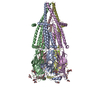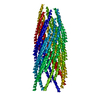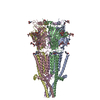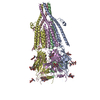[English] 日本語
 Yorodumi
Yorodumi- PDB-7koq: Alpha-7 nicotinic acetylcholine receptor bound to epibatidine in ... -
+ Open data
Open data
- Basic information
Basic information
| Entry | Database: PDB / ID: 7koq | ||||||||||||||||||||||||||||||||||||||||||||||||||||||||||||||||||||||||
|---|---|---|---|---|---|---|---|---|---|---|---|---|---|---|---|---|---|---|---|---|---|---|---|---|---|---|---|---|---|---|---|---|---|---|---|---|---|---|---|---|---|---|---|---|---|---|---|---|---|---|---|---|---|---|---|---|---|---|---|---|---|---|---|---|---|---|---|---|---|---|---|---|---|
| Title | Alpha-7 nicotinic acetylcholine receptor bound to epibatidine in a desensitized state | ||||||||||||||||||||||||||||||||||||||||||||||||||||||||||||||||||||||||
 Components Components | Neuronal acetylcholine receptor subunit alpha-7,Soluble cytochrome b562 fusion | ||||||||||||||||||||||||||||||||||||||||||||||||||||||||||||||||||||||||
 Keywords Keywords | MEMBRANE PROTEIN / Cys-loop receptor | ||||||||||||||||||||||||||||||||||||||||||||||||||||||||||||||||||||||||
| Function / homology |  Function and homology information Function and homology informationsensory processing / synaptic transmission involved in micturition / dendrite arborization / response to acetylcholine / Highly calcium permeable postsynaptic nicotinic acetylcholine receptors / acetylcholine receptor activity / acetylcholine-gated channel complex / regulation of amyloid fibril formation / acetylcholine-gated monoatomic cation-selective channel activity / short-term memory ...sensory processing / synaptic transmission involved in micturition / dendrite arborization / response to acetylcholine / Highly calcium permeable postsynaptic nicotinic acetylcholine receptors / acetylcholine receptor activity / acetylcholine-gated channel complex / regulation of amyloid fibril formation / acetylcholine-gated monoatomic cation-selective channel activity / short-term memory / cation channel complex / dendritic spine organization / chloride channel regulator activity / acetylcholine binding / regulation of amyloid precursor protein catabolic process / acetylcholine receptor signaling pathway / neurotransmitter receptor complex / positive regulation of amyloid-beta formation / positive regulation of protein metabolic process / negative regulation of amyloid-beta formation / response to amyloid-beta / ligand-gated ion channel signaling pathway / monoatomic ion channel activity / modulation of excitatory postsynaptic potential / plasma membrane raft / negative regulation of tumor necrosis factor production / positive regulation of excitatory postsynaptic potential / toxic substance binding / monoatomic ion transport / negative regulation of canonical NF-kappaB signal transduction / negative regulation of cytokine production involved in inflammatory response / positive regulation of long-term synaptic potentiation / response to nicotine / regulation of membrane potential / excitatory postsynaptic potential / electron transport chain / synapse organization / calcium channel activity / cognition / memory / positive regulation of angiogenesis / intracellular calcium ion homeostasis / calcium ion transport / transmembrane signaling receptor activity / amyloid-beta binding / monoatomic ion transmembrane transport / chemical synaptic transmission / postsynaptic membrane / learning or memory / periplasmic space / response to hypoxia / electron transfer activity / positive regulation of ERK1 and ERK2 cascade / postsynapse / neuron projection / positive regulation of MAPK cascade / iron ion binding / positive regulation of cell population proliferation / heme binding / synapse / dendrite / endoplasmic reticulum membrane / signal transduction / protein homodimerization activity / membrane / plasma membrane Similarity search - Function | ||||||||||||||||||||||||||||||||||||||||||||||||||||||||||||||||||||||||
| Biological species |  Homo sapiens (human) Homo sapiens (human) | ||||||||||||||||||||||||||||||||||||||||||||||||||||||||||||||||||||||||
| Method | ELECTRON MICROSCOPY / single particle reconstruction / cryo EM / Resolution: 3.6 Å | ||||||||||||||||||||||||||||||||||||||||||||||||||||||||||||||||||||||||
 Authors Authors | Noviello, C.M. / Hibbs, R.E. / Gharpure, A. / Mukhtasimova, N. / Cabuco, R. / Baxter, L. / Borek, D. / Sine, S. | ||||||||||||||||||||||||||||||||||||||||||||||||||||||||||||||||||||||||
| Funding support |  United States, 2items United States, 2items
| ||||||||||||||||||||||||||||||||||||||||||||||||||||||||||||||||||||||||
 Citation Citation |  Journal: Cell / Year: 2021 Journal: Cell / Year: 2021Title: Structure and gating mechanism of the α7 nicotinic acetylcholine receptor. Authors: Colleen M Noviello / Anant Gharpure / Nuriya Mukhtasimova / Rico Cabuco / Leah Baxter / Dominika Borek / Steven M Sine / Ryan E Hibbs /  Abstract: The α7 nicotinic acetylcholine receptor plays critical roles in the central nervous system and in the cholinergic inflammatory pathway. This ligand-gated ion channel assembles as a homopentamer, is ...The α7 nicotinic acetylcholine receptor plays critical roles in the central nervous system and in the cholinergic inflammatory pathway. This ligand-gated ion channel assembles as a homopentamer, is exceptionally permeable to Ca, and desensitizes faster than any other Cys-loop receptor. The α7 receptor has served as a prototype for the Cys-loop superfamily yet has proven refractory to structural analysis. We present cryo-EM structures of the human α7 nicotinic receptor in a lipidic environment in resting, activated, and desensitized states, illuminating the principal steps in the gating cycle. The structures also reveal elements that contribute to its function, including a C-terminal latch that is permissive for channel opening, and an anionic ring in the extracellular vestibule that contributes to its high conductance and calcium permeability. Comparisons among the α7 structures provide a foundation for mapping the gating cycle and reveal divergence in gating mechanisms in the Cys-loop receptor superfamily. | ||||||||||||||||||||||||||||||||||||||||||||||||||||||||||||||||||||||||
| History |
|
- Structure visualization
Structure visualization
| Movie |
 Movie viewer Movie viewer |
|---|---|
| Structure viewer | Molecule:  Molmil Molmil Jmol/JSmol Jmol/JSmol |
- Downloads & links
Downloads & links
- Download
Download
| PDBx/mmCIF format |  7koq.cif.gz 7koq.cif.gz | 669.5 KB | Display |  PDBx/mmCIF format PDBx/mmCIF format |
|---|---|---|---|---|
| PDB format |  pdb7koq.ent.gz pdb7koq.ent.gz | 560.2 KB | Display |  PDB format PDB format |
| PDBx/mmJSON format |  7koq.json.gz 7koq.json.gz | Tree view |  PDBx/mmJSON format PDBx/mmJSON format | |
| Others |  Other downloads Other downloads |
-Validation report
| Summary document |  7koq_validation.pdf.gz 7koq_validation.pdf.gz | 1.5 MB | Display |  wwPDB validaton report wwPDB validaton report |
|---|---|---|---|---|
| Full document |  7koq_full_validation.pdf.gz 7koq_full_validation.pdf.gz | 1.6 MB | Display | |
| Data in XML |  7koq_validation.xml.gz 7koq_validation.xml.gz | 68.5 KB | Display | |
| Data in CIF |  7koq_validation.cif.gz 7koq_validation.cif.gz | 97.5 KB | Display | |
| Arichive directory |  https://data.pdbj.org/pub/pdb/validation_reports/ko/7koq https://data.pdbj.org/pub/pdb/validation_reports/ko/7koq ftp://data.pdbj.org/pub/pdb/validation_reports/ko/7koq ftp://data.pdbj.org/pub/pdb/validation_reports/ko/7koq | HTTPS FTP |
-Related structure data
| Related structure data |  22980MC  7kooC  7koxC M: map data used to model this data C: citing same article ( |
|---|---|
| Similar structure data |
- Links
Links
- Assembly
Assembly
| Deposited unit | 
|
|---|---|
| 1 |
|
- Components
Components
| #1: Protein | Mass: 63832.293 Da / Num. of mol.: 5 Source method: isolated from a genetically manipulated source Source: (gene. exp.)  Homo sapiens (human), (gene. exp.) Homo sapiens (human), (gene. exp.)  Gene: CHRNA7, NACHRA7, cybC / Production host:  Homo sapiens (human) / References: UniProt: P36544, UniProt: P0ABE7 Homo sapiens (human) / References: UniProt: P36544, UniProt: P0ABE7#2: Polysaccharide | 2-acetamido-2-deoxy-beta-D-glucopyranose-(1-4)-2-acetamido-2-deoxy-beta-D-glucopyranose Source method: isolated from a genetically manipulated source #3: Sugar | ChemComp-NAG / #4: Chemical | ChemComp-EPJ / #5: Chemical | ChemComp-CA / Has ligand of interest | N | Has protein modification | Y | |
|---|
-Experimental details
-Experiment
| Experiment | Method: ELECTRON MICROSCOPY |
|---|---|
| EM experiment | Aggregation state: PARTICLE / 3D reconstruction method: single particle reconstruction |
- Sample preparation
Sample preparation
| Component | Name: alpha 7 nicotinic receptor in complex with the agonist epibatidine Type: COMPLEX / Entity ID: #1 / Source: RECOMBINANT |
|---|---|
| Molecular weight | Experimental value: NO |
| Source (natural) | Organism:  Homo sapiens (human) Homo sapiens (human) |
| Source (recombinant) | Organism:  Homo sapiens (human) Homo sapiens (human) |
| Buffer solution | pH: 7.4 |
| Specimen | Embedding applied: NO / Shadowing applied: NO / Staining applied: NO / Vitrification applied: YES |
| Vitrification | Cryogen name: ETHANE |
- Electron microscopy imaging
Electron microscopy imaging
| Experimental equipment |  Model: Titan Krios / Image courtesy: FEI Company |
|---|---|
| Microscopy | Model: FEI TITAN KRIOS |
| Electron gun | Electron source:  FIELD EMISSION GUN / Accelerating voltage: 300 kV / Illumination mode: FLOOD BEAM FIELD EMISSION GUN / Accelerating voltage: 300 kV / Illumination mode: FLOOD BEAM |
| Electron lens | Mode: BRIGHT FIELD |
| Image recording | Electron dose: 70 e/Å2 / Film or detector model: GATAN K3 (6k x 4k) |
- Processing
Processing
| Software | Name: PHENIX / Version: 1.19_4080: / Classification: refinement | ||||||||||||||||||||||||
|---|---|---|---|---|---|---|---|---|---|---|---|---|---|---|---|---|---|---|---|---|---|---|---|---|---|
| EM software | Name: PHENIX / Category: model refinement | ||||||||||||||||||||||||
| CTF correction | Type: PHASE FLIPPING AND AMPLITUDE CORRECTION | ||||||||||||||||||||||||
| 3D reconstruction | Resolution: 3.6 Å / Resolution method: OTHER / Num. of particles: 1790185 / Details: Resolve CryoEM Density Modification, FSC=0.5 / Symmetry type: POINT | ||||||||||||||||||||||||
| Refinement | Highest resolution: 3.6 Å | ||||||||||||||||||||||||
| Refine LS restraints |
|
 Movie
Movie Controller
Controller













 PDBj
PDBj













